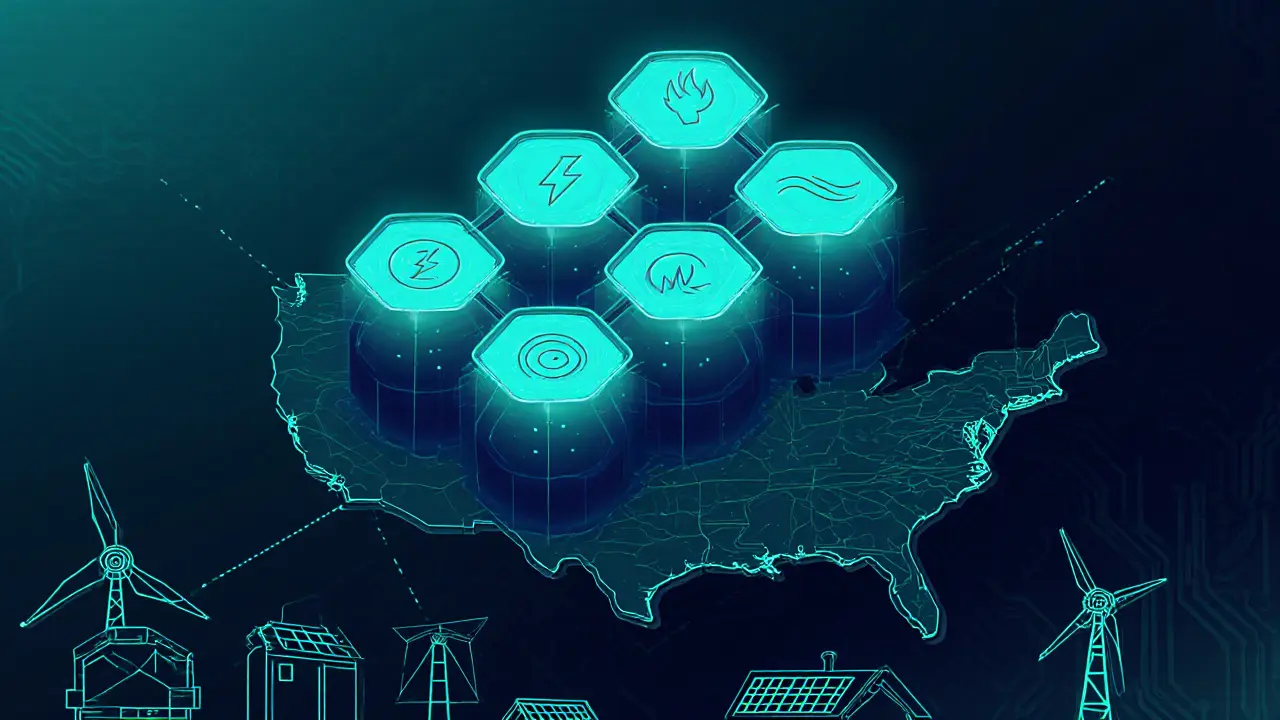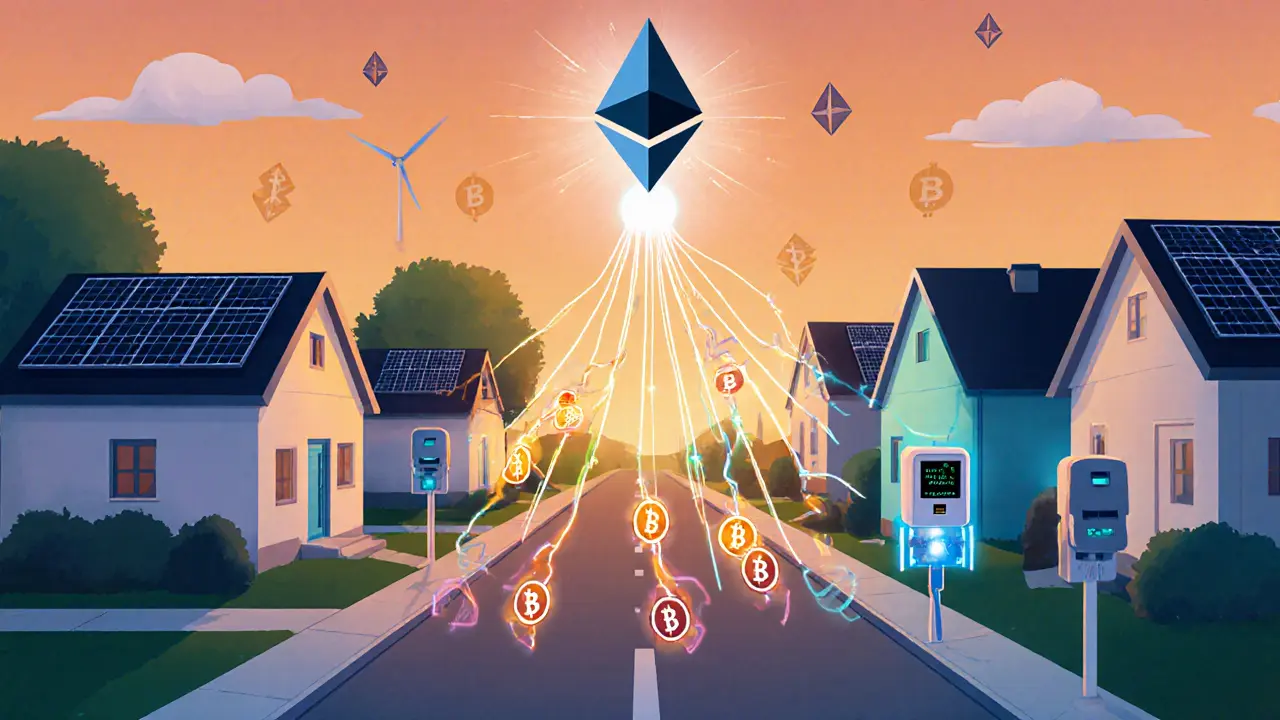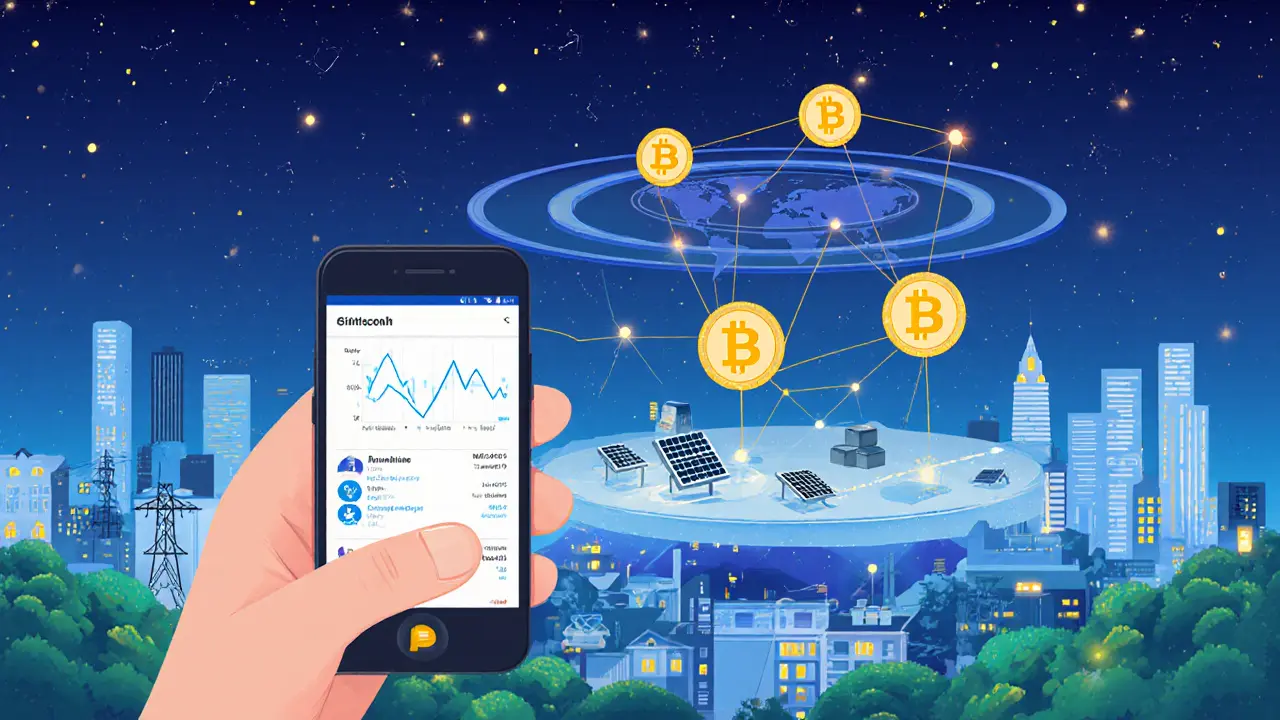May 12, 2025, Posted by: Ronan Caverly

Blockchain Energy Market Value Estimator
Market Growth Analysis
Key Metrics
Current Market Size (2025): $4.4 billion
Projected Size (2035): $142 billion
Annual Growth Rate: 41.6%
Market Impact
By 2035, the blockchain-energy sector could reach $142 billion, representing a compound annual growth rate of 41.6%.
This growth reflects increasing adoption of decentralized energy trading, smart contracts, and tokenized assets.
When Blockchain is described as a distributed ledger that records transactions in an immutable, transparent way, most people think of cryptocurrencies. Yet the same technology is reshaping how electricity, gas, and heat are bought, sold, and managed. In 2025 the blockchain‑energy sector was valued at USD 4.4billion, and analysts forecast it could soar past USD 142billion by 2035. That growth isn’t hype - it’s driven by real‑world use cases that cut costs, eliminate middlemen, and give every kilowatt‑hour a trustworthy digital fingerprint.
Key Takeaways
- Blockchain creates peer‑to‑peer (P2P) energy markets where households sell surplus solar directly to neighbors.
- Smart contracts on platforms like Ethereum automate payments, grid‑balancing, and compliance.
- Tokenized renewable energy certificates (RECs) and carbon credits bring transparency to sustainability claims.
- Private blockchains dominate today’s deployments, but public networks are gaining ground for open marketplaces.
- Implementation challenges-security, integration, regulation-are solvable with proper design and auditing.
1. Why Blockchain Fits Energy Markets
Energy trading has three pain points: (1) data silos, (2) costly intermediaries, and (3) trust gaps between producers and consumers. A blockchain ledger solves all three by providing a single source of truth that participants can verify without a central authority.
In a typical setup, Energy Market the ecosystem of producers, distributors, retailers, and end‑users that buy and sell energy is divided into micro‑segments. Each segment records its transactions on a shared chain, making audits immediate and tamper‑proof. This transparency is especially valuable for regulatory reporting, such as proving compliance with renewable portfolio standards.
2. Peer‑to‑Peer Energy Trading in Practice
Imagine a suburban street where three homes have rooftop solar, one has a small wind turbine, and two rely on the grid. With a blockchain‑enabled P2P platform, the surplus produced by the solar house is tokenized into energy credits. Those credits are instantly transferred to a neighbor who needs power at that moment, and the smart meter updates the balance automatically.
Key components of a P2P model:
- Smart Meter an IoT‑enabled device that measures real‑time electricity consumption and generation reports data to the blockchain.
- IoT Device sensors and controllers that feed granular grid data into digital ledgers ensure the system knows who is producing and who is consuming.
- Participants sign transactions with cryptographic keys, guaranteeing that only the rightful owner can sell or buy energy.
By 2025 residential participation grew 20%, showing that homeowners are willing to trade directly when the process is simple and secure.
3. Smart Contracts: The Automation Engine
Smart contracts are self‑executing code that lives on the chain. When conditions are met-say, a meter records 5kWh produced-the contract instantly triggers a payment in fiat or a token. The most popular platform for energy smart contracts is Ethereum a public blockchain that supports Turing‑complete smart contracts and a vibrant developer ecosystem. Its ERC‑20 and ERC‑1155 token standards are used to represent energy units, RECs, and carbon credits alike.
Why smart contracts matter:
- Eliminate manual billing and reconciliation.
- Enable real‑time demand‑response by automatically curtailing load when the grid is stressed.
- Provide immutable proof of delivery for regulatory audits.
More than 70% of blockchain‑energy investments in 2025 were earmarked for smart‑contract development, underscoring their central role.

4. Tokenizing Renewable Energy Certificates and Carbon Credits
Renewable Energy Certificates (RECs) prove that a megawatt‑hour of clean power was generated. Traditionally, RECs are issued on paper or centralized databases, opening the door to fraud. By tokenizing RECs on a blockchain, each certificate becomes a unique, traceable digital asset.
Similarly, carbon credits can be tokenized as Tokenized Carbon Credit a blockchain‑based representation of verified carbon emission reductions. Companies can buy, sell, or retire these tokens with full auditability, which drives confidence in corporate sustainability claims.
In 2025 the global REC market hit $28billion, and blockchain‑enabled solutions accounted for roughly 30% of new issuances. Carbon‑credit token volume grew 25‑30% annually, reflecting strong demand for verifiable offsets.
5. Public vs Private Blockchains: Which Fits Your Use Case?
| Attribute | Public Blockchain | Private Blockchain |
|---|---|---|
| Control | Open, anyone can join | Permissioned, governed by consortium |
| Transparency | Fully visible to all participants | Selective visibility for privacy |
| Scalability | Generally slower, limited TPS | Higher throughput, customized consensus |
| Use Cases | Open energy marketplaces, tokenized assets | Utility‑level DER management, internal settlement |
| Adoption Share (2025) | ~35% | ~65% |
Because utilities need to protect customer data and meet strict regulatory standards, private blockchains dominate early deployments. Start‑ups aiming for global marketplaces often choose public chains to reach a broader audience.
6. Market Landscape and Growth Drivers
Regional breakdown shows Europe leading with a 35% share (≈USD1.94billion) followed by North America at 16% in 2024. Commercial entities drive 45% of adoption, motivated by cost savings and operational efficiency. The industrial sector, especially high‑energy manufacturers, is projected to grow at a 28% CAGR through 2030 as they track renewable usage for ESG reporting.
Key growth levers:
- Government incentives for blockchain‑enabled renewable certification.
- Venture capital flowing into startups offering P2P platforms and tokenized asset services.
- Integration with AI for predictive demand‑response and price forecasting.
By 2034 the overall market is expected to hit $90.8billion, with a steady 41.6% annual growth rate from 2025 onward.
7. Implementation Challenges and Best Practices
Deploying blockchain isn’t a plug‑and‑play affair. Common hurdles include:
- Security Risks: 51% attacks, smart‑contract bugs, and DoS threats demand regular code audits and multi‑signature wallets.
- Integration Complexity: Legacy SCADA systems must talk to blockchain nodes, often via middleware or APIs.
- Regulatory Uncertainty: Energy tariffs, data privacy, and token classification differ by jurisdiction.
Best‑practice checklist:
- Start with a pilot covering a single DER cluster.
- Choose a permissioned ledger if data privacy is paramount.
- Engage third‑party auditors for smart‑contract verification.
- Develop clear governance rules for token issuance and retirement.
- Train operational staff on blockchain fundamentals and cyber‑hygiene.
Following these steps reduces risk and accelerates ROI, which many utilities report within 12‑18months of launch.
8. Looking Ahead: What’s Next for Blockchain in Energy?
The next wave will blend blockchain with AI, IoT, and advanced analytics. Predictive algorithms will trigger smart‑contract settlements before markets open, optimizing price signals in real time. Tokenized micro‑investments will let individuals fund community solar projects through a mobile app, democratizing access to clean energy assets.
Regulators are drafting frameworks that recognize blockchain‑issued RECs as legal proof, which will eliminate the current patchwork of certification bodies. As scalability solutions-like layer‑2 rollups and permissioned sidechains-mature, transaction costs will drop below a cent per kilowatt‑hour, making blockchain the default backbone for future energy markets.

Frequently Asked Questions
How does blockchain reduce the cost of energy trading?
By eliminating intermediaries, automating settlements with smart contracts, and providing a single, auditable ledger, transaction fees drop from several percent to fractions of a cent per kilowatt‑hour.
Can I use a public blockchain for my utility’s DER management?
Yes, but most utilities prefer permissioned (private) blockchains because they offer higher throughput and stricter data‑privacy controls required by regulators.
What is a tokenized renewable energy certificate?
It’s a digital token that represents one megawatt‑hour of verified renewable generation, stored on a blockchain so its ownership and retirement history are immutable.
Are there security concerns specific to energy blockchains?
Common risks include 51% attacks on smaller networks, vulnerabilities in smart‑contract code, and denial‑of‑service attacks on node infrastructure. Regular audits and multi‑signature wallets mitigate most threats.
How can households start trading solar surplus on a blockchain platform?
First, install a compatible smart meter that can push data to the blockchain. Then register on a P2P marketplace, receive a digital wallet, and start creating energy‑credit tokens whenever your panels produce excess power.
Write a comment
Comments
Logan Cates
Oh great, another hype train about blockchain fixing energy, just what we needed.
May 12, 2025 AT 23:02
Shelley Arenson
Wow, this is super exciting! 🚀 I love how blockchain can make energy trading more transparent and fair. Keep the info coming, it really helps us understand the future of clean power! 😊
May 14, 2025 AT 22:15
Joel Poncz
yeah, thsi is realy interesting. i think the idea of tokenized RECs could finally stop the fraud that happens with paper certificates. it's kinda cool how the ledger makes everything traceable.
May 16, 2025 AT 21:28
Kris Roberts
When you step back and look at the bigger picture, blockchain isn’t just a tech buzzword-it’s a philosophy of openness that aligns well with the decentralization of power generation. Imagine each household as a node in a network, both consuming and producing, negotiating prices in real time. That kind of peer‑to‑peer dynamic could reduce waste, cut fees, and democratize access to clean energy. Of course, the rollout isn’t without hurdles: scalability, regulatory frameworks, and the need for robust cyber‑security. But the potential for a more resilient and participatory grid is worth the effort, especially as we chase net‑zero targets.
May 18, 2025 AT 20:42
Drizzy Drake
First off, I want to say that the momentum we’re seeing in blockchain‑enabled energy markets feels like the early days of the internet-full of promise, a bit chaotic, but undeniably transformative. The idea of a shared immutable ledger means that every kilowatt‑hour can be accounted for without a middleman, which could shave off the hefty transaction fees that have plagued traditional energy trading for decades. Smart contracts automate settlements, so when your rooftop solar generates a surplus, the payment can be triggered instantly, cutting down on paperwork and delays. Moreover, tokenized renewable energy certificates bring a level of trust that paper‑based RECs simply can’t match; each token’s history is visible to anyone, making fraud a lot harder.
When we talk about scalability, yes, public blockchains like Ethereum have throughput limits, but newer layer‑2 solutions and permissioned sidechains are already delivering thousands of transactions per second, bringing costs down to fractions of a cent per kilowatt‑hour. This is crucial for real‑time pricing and demand‑response programs that need rapid, automated reactions.
On the regulatory side, governments are beginning to draft frameworks that recognize blockchain‑issued certificates as legal proof, which will streamline compliance and reduce the patchwork of certification bodies that currently exist. This alignment between policy and technology will accelerate adoption across utilities, municipalities, and even small community micro‑grids.
From a financial perspective, venture capital is pouring into startups that combine IoT sensors, AI analytics, and blockchain, creating an ecosystem where predictive algorithms can trigger smart‑contract settlements before markets even open. Imagine a future where your home’s energy store automatically sells excess power at peak prices, while you sleep, all without lifting a finger.
Security remains a top concern-51% attacks, smart‑contract bugs, and DDoS threats are real-but regular audits, multi‑signature wallets, and rigorous testing can mitigate most of these risks. The industry is learning fast, and best‑practice checklists are becoming standard.
In short, while we’re not at the finish line yet, the convergence of blockchain, IoT, and AI is setting the stage for an energy market that is more democratic, efficient, and resilient. If we keep pushing forward with thoughtful design and robust governance, the $142 billion forecast for 2035 could be just the beginning of a greener, more decentralized world.
May 20, 2025 AT 19:55
AJAY KUMAR
While everyone’s busy glorifying Western tech, let’s not forget that India has been piloting decentralized micro‑grids for years, using blockchain to empower villages that never saw reliable power. Our engineers built a permissioned ledger that handles thousands of transactions per second, all while staying under a fraction of the cost that the big tech giants charge. It’s time the world recognized that true innovation often comes from the ground up, not from the glossy labs of Silicon Valley.
May 22, 2025 AT 19:08
bob newman
Oh sure, because we all know that every blockchain project magically solves the energy crisis without any hiccups-just like that miracle pill you read about on a forum last summer. If only the math were that simple, we’d have everyone riding solar‑powered hoverboards by now.
May 24, 2025 AT 18:22
Anil Paudyal
simple but effective.
May 26, 2025 AT 17:35
Kimberly Gilliam
Wow. Another "revolution" that will totally change everything. 🙄 I guess we’ll all be token‑rich soon.
May 28, 2025 AT 16:48
Jeannie Conforti
Great overview! If you’re just getting started, try looking at open‑source frameworks like Hyperledger Fabric – they’re well‑documented and can help you prototype without huge upfront costs.
May 30, 2025 AT 16:02
tim nelson
I think the key here is balance. Too much hype can scare regulators, but too little makes investors nervous. Finding that sweet spot will be crucial for real adoption.
June 1, 2025 AT 15:15
Zack Mast
Consider this: the very act of recording energy transactions on a blockchain mirrors the philosophical quest for truth-immutable, unaltered, forever. When we entrust our power grids to such a system, we’re not just trading kilowatts; we’re embracing a deeper commitment to transparency that resonates beyond mere economics.
June 3, 2025 AT 14:28
Dale Breithaupt
Let’s keep the momentum going! Every small pilot you see is a step toward a larger, greener future. If you’re passionate, share your ideas and help the community grow.
June 5, 2025 AT 13:42
Rasean Bryant
The outlook is bright, and with careful planning, we can achieve those ambitious market goals while staying sustainable.
June 7, 2025 AT 12:55
Angie Food
Honestly, most of this sounds like buzzword bingo. I doubt we’ll see real impact beyond a few niche projects.
June 9, 2025 AT 12:08
Jonathan Tsilimos
While your skepticism is noted, the quantitative metrics-such as a projected CAGR of 41.6% and the tokenization throughput improvements-provide a substantive foundation that transcends mere speculation.
June 11, 2025 AT 11:22
jeffrey najar
If you’re looking to implement a blockchain solution, start with a clear governance model and engage a reputable auditor early. This mitigates risk and builds stakeholder confidence.
June 13, 2025 AT 10:35
Rochelle Gamauf
One must question whether the proliferation of blockchain in energy markets is driven by genuine utility or merely by speculative capital seeking the next hype cycle. The discourse would benefit from a more rigorous, evidence‑based analysis.

Author
Ronan Caverly
I'm a blockchain analyst and market strategist bridging crypto and equities. I research protocols, decode tokenomics, and track exchange flows to spot risk and opportunity. I invest privately and advise fintech teams on go-to-market and compliance-aware growth. I also publish weekly insights to help retail and funds navigate digital asset cycles.